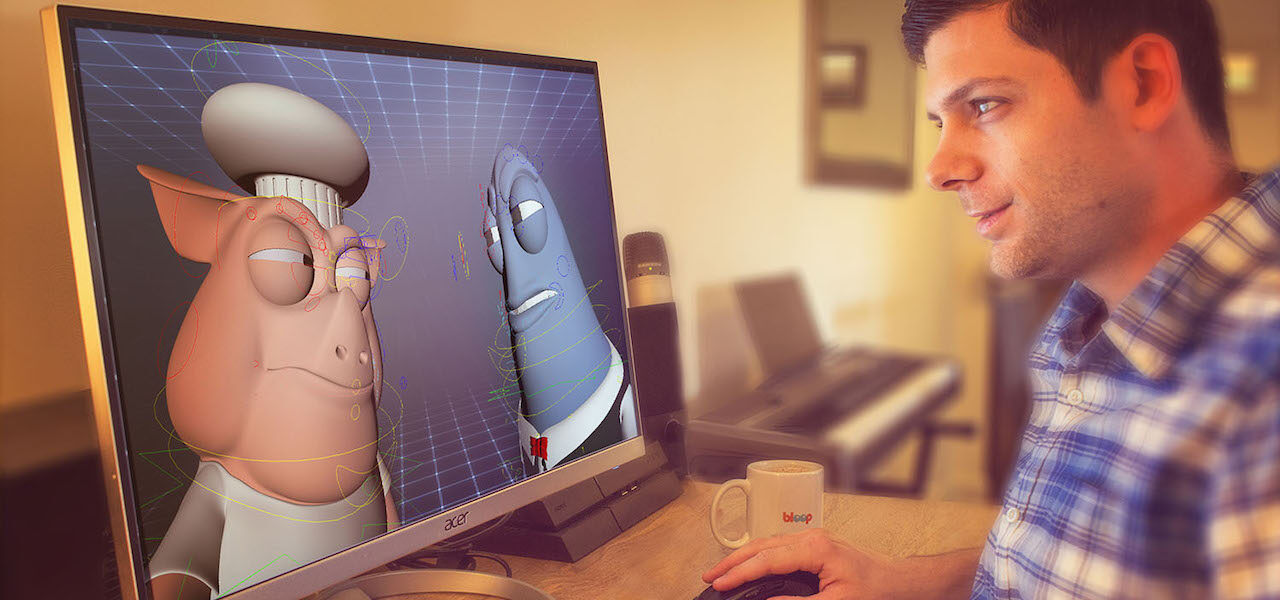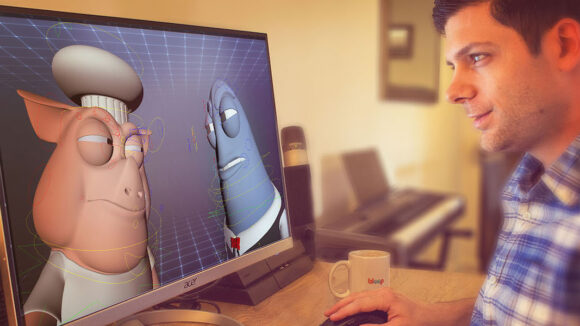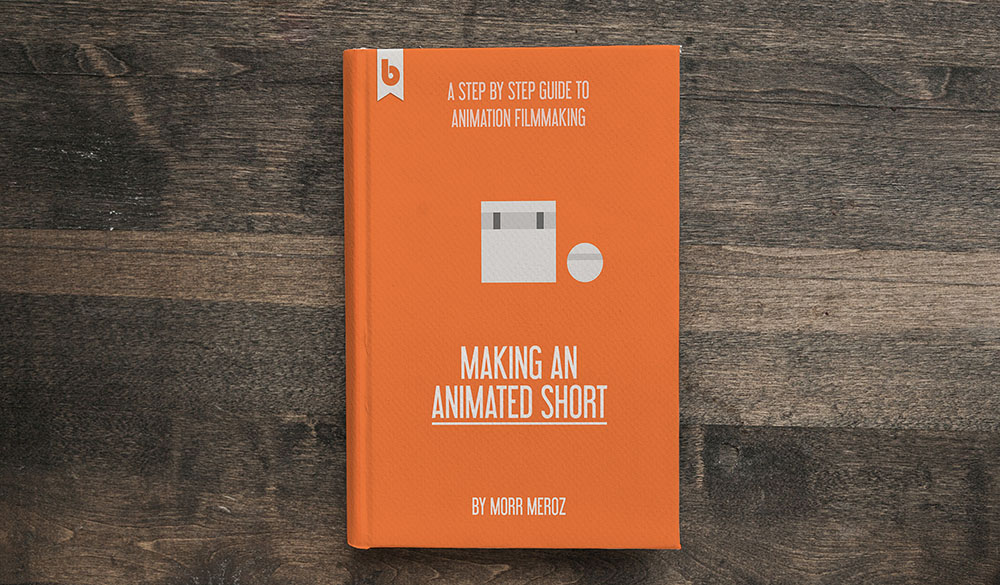

Learning Animation At Home: Bloop Animation’s Guide On Where To Start
As we all find ourselves stuck at home, many are searching for ways to stay productive. This may be a good time to learn a new skill, and Bloop Animation offers a wide variety of premium video courses for many different animation programs.
For those who have always dreamed of doing animation, filmmaker Morr Meroz has put together this quick guide to help you get started. After graduating from the School of Visual Arts, Meroz founded Bloop Animation and started producing animated short films. The company’s animation learning platform has helped over 16,000 students take their first steps into the world of animation through dozens of courses, books, and tutorials about animation filmmaking.
In this guide, Meroz will go over the reasons why learning animation online is a great option, as well as which Bloop Animation course is right for you based on your experience and preferences.
Here’s Meroz:

First: why online animation courses are so awesome
Online courses have become insanely popular in recent years, and they keep getting better and better. We’ve come a long way since the days of random Youtube tutorials. Online video courses are now well produced, and a very effective alternative to traditional schools.
Here’s why you should consider learning animation with online courses:
It’s cheaper — much cheaper
Art schools are insanely expensive. Spending $20,000-$50,000 dollars a year (and most likely getting into debt) is a huge decision, and it’s getting less and less valuable.
Online courses only set you back a few hundred dollars (maybe a few thousand if you’re doing an online certificate program). This makes it much more accessible to a wide range of artists who in the past would have had to give up on their dream, or borrow a ton of money.
It’s a great test-drive
Maybe animation isn’t for you? Wouldn’t it be great to find that out before spending tens of thousands of dollars and precious years of your life? Taking an online animation course is a cheap and efficient way to check if you’re up for the task. See if you like it.
You don’t really need a degree anyway
One of the benefits of working in a creative industry like animation is that your work speaks more loudly than any credential in your résumé. If your demo reel is good, you will be hired. No one will care what school you didn’t go to.
You can study while working
A great thing about online courses is that you can take them in your spare time. If you’re transitioning from a different profession, or working full-time for any other reason, you can take these courses during weekends, evenings, and lunch breaks.
You can customize your own learning path
Another benefit of online education is that you can combine sources from different places. In a traditional school you have to stick to the program (usually three to four years) and often take a lot of courses you have no interest in, or that don’t really contribute to your personal growth. With online courses, you can construct your own learning path.
It’s a great way to maximize your education (while in school)
You can also take online courses while being a student in a traditional program. When I went to art school, I constantly looked for online courses and tutorials, and watched whatever I could get my hands on. Doing that while at school really pushed my skills and motivated me to work harder and get better.
You can start right now
A bonus reason to learn animation online: you can start today! No waiting for the semester to start, or to hear if you’re accepted or not. You can decide learning animation is for you right this moment, and get started within five minutes!

Second: choosing your software
So you’re convinced taking an online animation course is a good idea. But how do you decide which software is best for you? First, it’s worth asking yourself: who are you?
I’m a total beginner
You’ve never animated anything in your life, but you always wanted to try it out. First, no matter which software you decide to go with, learning the basics is crucial. Bloop Animation’s Animation Foundations course will help you cover your bases by teaching the basic principles of character animation.
If you’re planning to make your own film, a good start is the Storyboarding Foundations course, which not only teaches the basics of storyboarding art, but also covers the best software to make those boards.
To finish it off, you can take Making an Animated Movie course. It covers the process of making an animated short film from start to finish. It’s a great intro to animation filmmaking, and it comes bundled with any of Bloop Animation’s courses.
After understanding the basics, it’s time to decide which software is best for you.
Can you draw? If so, the best place to start is Animate CC, as it is relatively cheap and easy to learn, especially if you’ve used Adobe programs in the past. Animate CC can produce very impressive high-quality 2d hand-drawn animations, as well as simplistic easy-to-make animations.
If you’re not into drawing, a better solution might be After Effects, Character Animator, or Blender.
After Effects is great because it allows you to create a character once and manipulate it in the program, sort of like a 2d puppet, to create the animation. No drawing needed. Bloop Animation’s After Effects course teaches exactly that, and is great if drawing isn’t your strong suit.
Adobe’s Character Animator doesn’t require any animation skills. You use a webcam and a microphone to drive the character’s performance. Like motion capture, but much simpler. It’s a great option for people who have never animated before.
Blender is a great option for beginners because it’s free, and while it is still a robust 3d animation program, it’s not as intimidating as Maya. The fact that it’s free makes it a low-risk option for beginners who want to test the water, and Bloop Animation’s Blender course teaches how to get a 3d rig and bring it into the program so you can have your first experience animating in 3d without much trouble.
I’ve done some animation in the past, and I want to push it further
If you have some experience with animation, Bloop Animation has courses that teach the most advanced animation programs in the world (2d and 3d). These courses work for beginners as well (the courses teach all the basics), but the programs covered are pretty robust.
For 2d, there are two great options for taking your animation to the highest level. The first one is Toon Boom Harmony. It’s an incredible professional-level animation software that can do almost anything in the realm of 2d animation, from stick figures to Disney-level results. The program allows for hand-drawn frame-by-frame animation, as well as a complex rigging system which is great for reusing pre-made assets without the need to redraw every frame. This is very common in animated tv shows.
The second option is TVPaint, which is a high-end professional animation software, focused on traditional hand-drawn animation style, like old-school Disney or Studio Ghibli. This is a great option if you plan on focusing on hand-drawn frame-by-frame animation in your project, and want the best solution for that pipeline.
For 3d, Bloop recommends either Blender or Maya. I’ve been working with Maya for years, both in the commercial world and for my own films. It is the industry standard for 3d animation, so if you’re planning on getting into the animation industry, this is your best option.
I’m a professional animator and am looking to expand my skills
If you already have plenty of animation experience, my suggestion is to try one of the programs you haven’t used. It’ll be relatively easy for you to switch from one to another (for example, if you’re used to Maya, Bloop Animation’s Blender course will be pretty easy, and you’ll be able to master that program in no time).
Also, it never hurts to expand other skills, and the Storyboarding Foundations course might help you improve your storytelling skills, which are extremely important for an animation filmmaker.
You may also be interested in the Making an Animated Movie course, which covers all the steps I took when making my latest animated short Tasteful.

Don’t leave without this free ebook
Hopefully, this guide will help you navigate your way into learning animation. But if you’re not ready to spend money on courses right now, you could at least check out Bloop Animation’s free ebook Making an Animated Short, which takes you step by step through the making of an animated short.
Happy learning!
